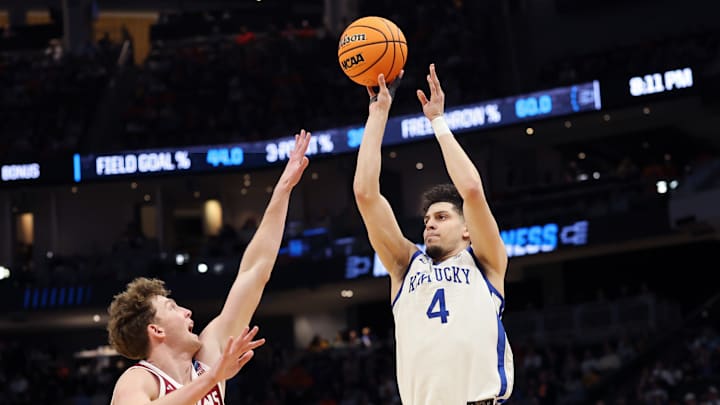Each day until the 2025 NBA Draft, Pippen Ain't Easy will profile one prospect who makes sense as a fit for the Bulls in either the first or second round. These players could fill a need, such as on-ball defense or rim protection, or could fit an archetype that Chicago lacks on its current roster, like an athletic big man or 3-and-D wing.
Do the Chicago Bulls need shooters? Probably not. The Bulls connected on the third-most triples at the 13th-best conversion rate a season ago. Chicago rostered 11 players, who appeared in at least 25 contests (you're welcome, Kevin Huerter), to average a three-point make per game. It's safe to say the Bulls prioritized the three.
Yet, there's always room for more shooting on every NBA team. And the draft class's best shooter will likely fall to the second round. That would be Kentucky's Koby Brea. The Dayton transfer spent four seasons suiting up for the Flyers before making his way to Lexington. Brea averaged a career-high 11.6 points per game while shooting 43.5 percent from three as a graduate senior.
Koby Brea's scouting report
Although Brea didn't enjoy the most prestigious collegiate career like most fifth-year seniors, his game is so easily translatable to the NBA that it doesn't matter. Through 149 appearances, Brea averaged merely 8.9 points per game. He never averaged more than four rebounds, two assists, or even one block per game in any season. But what he did do was knock down 317 three-pointers at a 43.3 percent clip.
Offense
Brea's biggest draw, by far and away, is his three-point shooting. His final collegiate season, where he drilled 2.6 threes per game at a 43.5 percent clip, wasn't even his best. As a senior at Dayton, Brea canned 3.0 triples per game at an NCAA-leading 49.8 percent clip. Brea made a mind-boggling 100 of 201 three-point attempts.
The 22-year-old is the 47th most accurate three-point marksman in NCAA history. Brea's fluid, sudden, and consistent mechanics led to impressive results. The former Wildcat utilizes a smooth, all-in-one motion release. His jumper is textbook, and he doesn't need to elevate considerably to get it off because his release is so quick. There's no telling when Brea will let it launch, off-the-catch or after a dribble or two.
Spotting up will certainly be Brea's primary function in the NBA, but his movement shooting must not be overlooked. The 22-year-old does a tremendous job coming off screens, hand-offs, and pin-downs. Upon the catch, Brea employs pump-fakes and side-step dribbles to create the space he needs to let it fly.
Aside from knockdown shooting, Brea doesn't provide much else on offense. He's a willing and connective passer, but averaged 1.1 assists per game throughout his career. You won't often catch Brea making the incorrect read or an overzealous play. The sharpshooter totaled merely 105 turnovers through 149 appearances. He's a smart player who rarely makes mistakes and understands his limitations.
Brea's handle sometimes looked compelling, but he just didn't use it enough. Almost all of Brea's dribbles came with a purpose. He's a straight-line driver who will utilize a crossover or step-back every once in a while, but again, his role wasn't to attack the basket at Dayton or Kentucky, and it won't be in the NBA.
Defense
He's a 6-foot-6, sharpshooting wing, he must fit the 3-and-D archetype, right? Not necessarily. Brea isn't a liability on the less glamorous end. He's smart, understands positioning, and has shown steady improvement in each and every season.
However, Brea's defensive ceiling is capped. He measured a tick below 6-foot-6 without shoes at the NBA Combine—solid height for an NBA wing. On the downside, Brea sports a negative wingspan, measuring only 6-feet-5 and a quarter. He was the lone combine participant to sport a wingspan less than his height this draft cycle.
Besides his subpar measurements, he was one of the slower combine participants, posting the third-slowest shuttle run and the 18th-worst three-quarter-sprint. Brea did post better-than-expected numbers in the no-step and max vertical leaps, where he finished middle-of-the-pack.
Without even average size and athleticism, Brea will have a difficult time defending in space at the next level. His off-ball defense holds up, but he's certainly not a playmaker, accumulating 60 steals and 37 blocks over five years collegiately. Brea must improve both his on-ball and off-ball defense to become a nightly contributor in the NBA.
Koby Brea's fit with the Chicago Bulls
As mentioned to begin the scouting report, Brea's three-point shooting is immediately translatable. He could play on opening night and contribute, solely by letting it fly from deep. He has legitimate NBA range and beyond, and is more than comfortable shooting on the move.
Interestingly enough, despite the Bulls' propensity to hoist as many three-pointers as possible, only one high-volume wing shooter is rostered—Kevin Huerter, who came to Chicago just four months ago. The Bulls' other wings, Matas Buzelis, Julian Phillips, Dalen Terry, and Patrick Williams, aren't high-volume or uber-efficient three-point marksmen. Williams averaged the most three-point field goals per game (1.5), while Buzelis was the most accurate (36.1 percent).
Chicago's inflated three-point numbers is largely due to the fact that 14 players attempted 100 or more three-pointers. Essentially, every single player on the roster wasn't shy to let it fly. Every Bull who averaged eight or more minutes per game averaged at least one three-point attempt.
Brea would come to Chicago as one of the few pure three-point specialists on the team. He's been compared to Sam Hauser and Duncan Robinson, and a Huerter comparison isn't far off. The 6-foot-6 wing is an elite shooter who fits on any and every offense in the modern-day NBA.
For more prospect profiles and all things draft-related, check out Pippen Ain't Easy'sChicago Bulls draft page. A new prospect's scouting report will be added daily.
